run flat TOYOTA SIENNA 2018 Owners Manual (in English)
[x] Cancel search | Manufacturer: TOYOTA, Model Year: 2018, Model line: SIENNA, Model: TOYOTA SIENNA 2018Pages: 584, PDF Size: 14.47 MB
Page 5 of 584
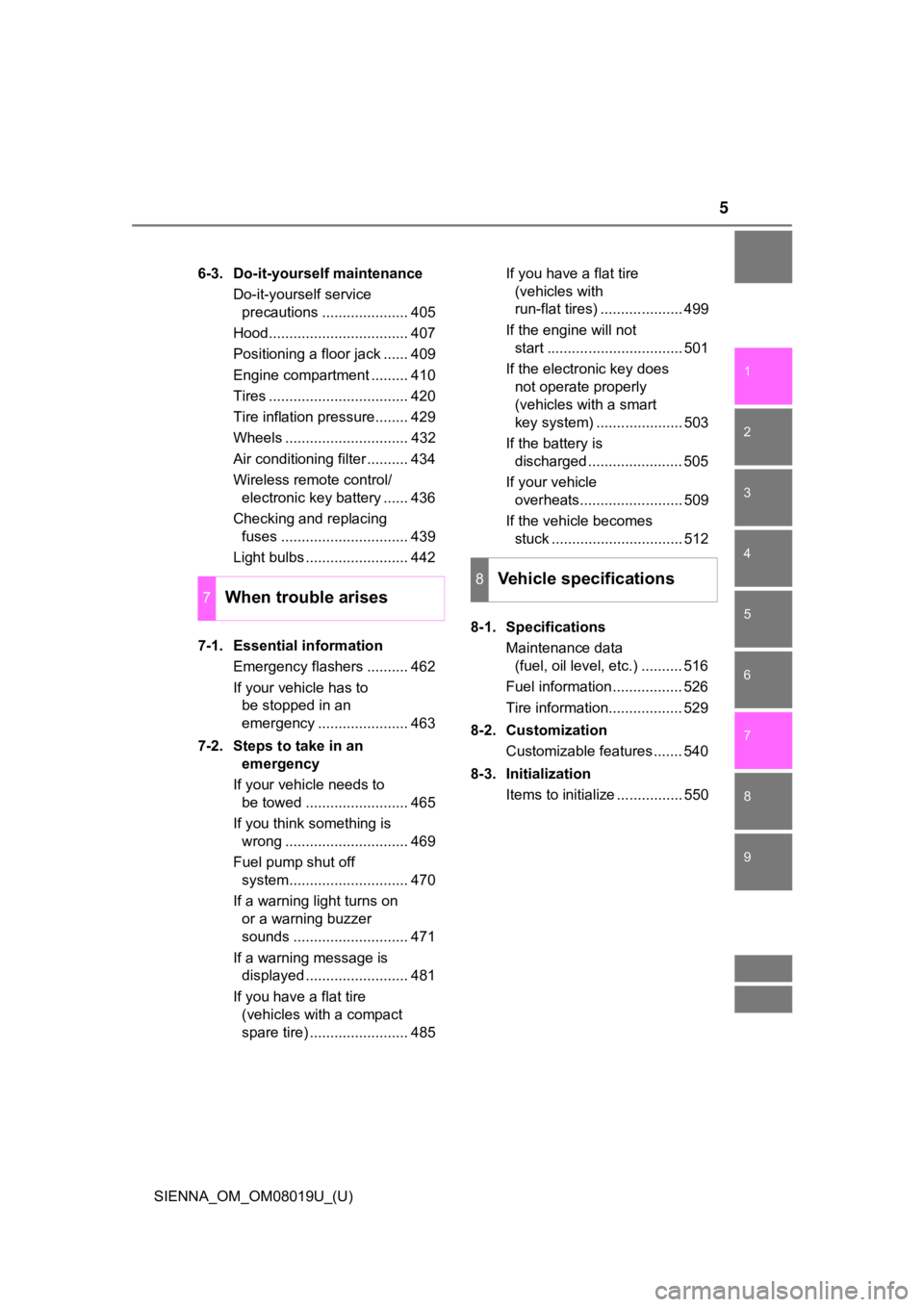
5
1
8 7
6
5
4
3
2
SIENNA_OM_OM08019U_(U)
9
6-3. Do-it-yourself maintenanceDo-it-yourself service precautions ..................... 405
Hood.................................. 407
Positioning a floor jack ...... 409
Engine compartment ......... 410
Tires .................................. 420
Tire inflation pressure........ 429
Wheels .............................. 432
Air conditioning filter .......... 434
Wireless remote control/ electronic key battery ...... 436
Checking and replacing fuses ............................... 439
Light bulbs ......................... 442
7-1. Essential information Emergency flashers .......... 462
If your vehicle has to be stopped in an
emergency ...................... 463
7-2. Steps to take in an emergency
If your vehicle needs to be towed ......................... 465
If you think something is wrong .............................. 469
Fuel pump shut off system............................. 470
If a warning light turns on or a warning buzzer
sounds ............................ 471
If a warning message is displayed ......................... 481
If you have a flat tire (vehicles with a compact
spare tire) ........................ 485 If you have a flat tire
(vehicles with
run-flat tires) .................... 499
If the engine will not start ................................. 501
If the electronic key does not operate properly
(vehicles with a smart
key system) ..................... 503
If the battery is discharged ....................... 505
If your vehicle overheats......................... 509
If the vehicle becomes stuck ................................ 512
8-1. Specifications Maintenance data (fuel, oil level, etc.) .......... 516
Fuel information ................. 526
Tire information.................. 529
8-2. Customization Customizable features ....... 540
8-3. Initialization Items to initialize ................ 550
7When trouble arises
8Vehicle specifications
Page 269 of 584

SIENNA_OM_OM08019U_(U)
2694-5. Using the driving support systems
4
Driving
WARNING
■When to disable the pre-collision system
In the following situations, disable the system, as it may not operate prop-
erly, possibly leading to an accident resulting in death or ser ious injury:
● When the vehicle is being towed
● When your vehicle is towing another vehicle
● When transporting the vehicle via truck, boat, train or similar means of
transportation
● When the vehicle is raised on a lift with the engine running an d the tires
are allowed to rotate freely
● When inspecting the vehicle using a drum tester such as a chass is dyna-
mometer or speedometer tester, or when using an on vehicle whee l bal-
ancer
● When a strong impact is applied to the front bumper or front gr ille, due to
an accident or other reasons
● If the vehicle cannot be driven in a stable manner, such as when the vehi-
cle has been in an accident or is malfunctioning
● When the vehicle is driven in a sporty manner or off-road
● When the tires are not properly inflated
● When the tires are very worn
● When tires of a size other than specified are installed
● When tire chains are installed
● When a compact spare tire is used
● If equipment (snow plow, etc.) that may obstruct the radar sens or or cam-
era sensor is temporarily installed to the vehicle
Page 277 of 584

SIENNA_OM_OM08019U_(U)
2774-5. Using the driving support systems
4
Driving
●In some situations such as the following, sufficient braking fo rce may not be
obtained, preventing the system from performing properly:
• If the braking functions cannot operate to their full extent, such as when
the brake parts are extremely cold, extremely hot, or wet
• If the vehicle is not properly maintained (brakes or tires are excessively
worn, improper tire inflation pressure, etc.)
• When the vehicle is being driven on a gravel road or other sli ppery sur-
face
● Some pedestrians such as the following may not be detected by t he radar
sensor and camera sensor, preventing the system from operating properly:
• Pedestrians shorter than approximately 3.2 ft. (1 m) or taller than approx-
imately 6.5 ft. (2 m)
• Pedestrians wearing oversized clothing (a rain coat, long skir t, etc.), mak-
ing their silhouette obscure
• Pedestrians who are carrying large baggage, holding an umbrella, etc., hiding part of their body
• Pedestrians who are bending forward or squatting
• Pedestrians who are pushing a stroller, wheelchair, bicycle or other vehi-
cle
• Groups of pedestrians which are close together
• Pedestrians who are wearing white and look extremely bright
• Pedestrians in the dark, such as at night or while in a tunnel
• Pedestrians whose clothing appears to be nearly the same color or
brightness as their surroundings
• Pedestrians near walls, fences, guardrails, or large objects
• Pedestrians who are on a metal object (manhole cover, steel plate, etc.)
on the road
• Pedestrians who are walking fast
• Pedestrians who are changing speed abruptly
• Pedestrians running out from behind a vehicle or a large objec t
• Pedestrians who are extremely close to the side of the vehicle (outside
rear view mirror, etc.)
Page 403 of 584
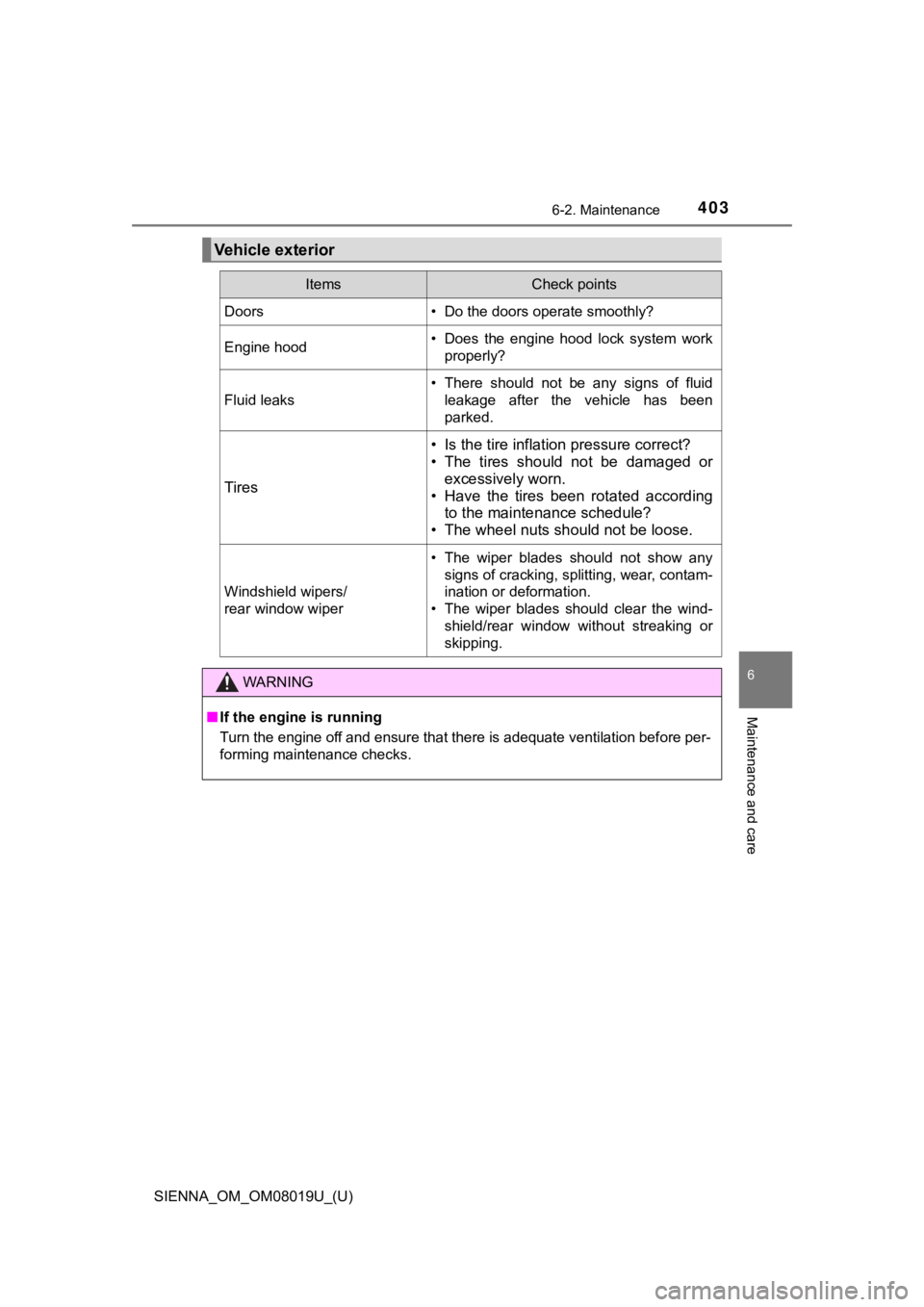
SIENNA_OM_OM08019U_(U)
4036-2. Maintenance
6
Maintenance and care
Vehicle exterior
ItemsCheck points
Doors• Do the doors operate smoothly?
Engine hood• Does the engine hood lock system workproperly?
Fluid leaks
• There should not be any signs of fluidleakage after the vehicle has been
parked.
Tires
• Is the tire inflation pressure correct?
• The tires should not be damaged orexcessively worn.
• Have the tires been rotated according to the maintenance schedule?
• The wheel nuts should not be loose.
Windshield wipers/
rear window wiper
• The wiper blades should not show any
signs of cracking, splitting, wear, contam-
ination or deformation.
• The wiper blades should clear the wind- shield/rear window without streaking or
skipping.
WARNING
■If the engine is running
Turn the engine off and ensure that there is adequate ventilati on before per-
forming maintenance checks.
Page 461 of 584

461
SIENNA_OM_OM08019U_(U)
7When trouble arises
7-1. Essential informationEmergency flashers .......... 462
If your vehicle has to be stopped in an
emergency ...................... 463 7-2. Steps to take in an
emergency
If your vehicle needs to be towed ......................... 465
If you think something is wrong .............................. 469
Fuel pump shut off system ............................ 470
If a warning light turns on or a warning buzzer
sounds ............................ 471
If a warning message is displayed......................... 481
If you have a flat tire (vehicles with a compact
spare tire)........................ 485
If you have a flat tire (vehicles with
run-flat tires).................... 499
If the engine will not start ................................. 501
If the electronic key does not operate properly
(vehicles with a smart
key system)..................... 503
If the battery is discharged ...................... 505
If your vehicle overheats ........................ 509
If the vehicle becomes stuck ............................... 512
Page 465 of 584
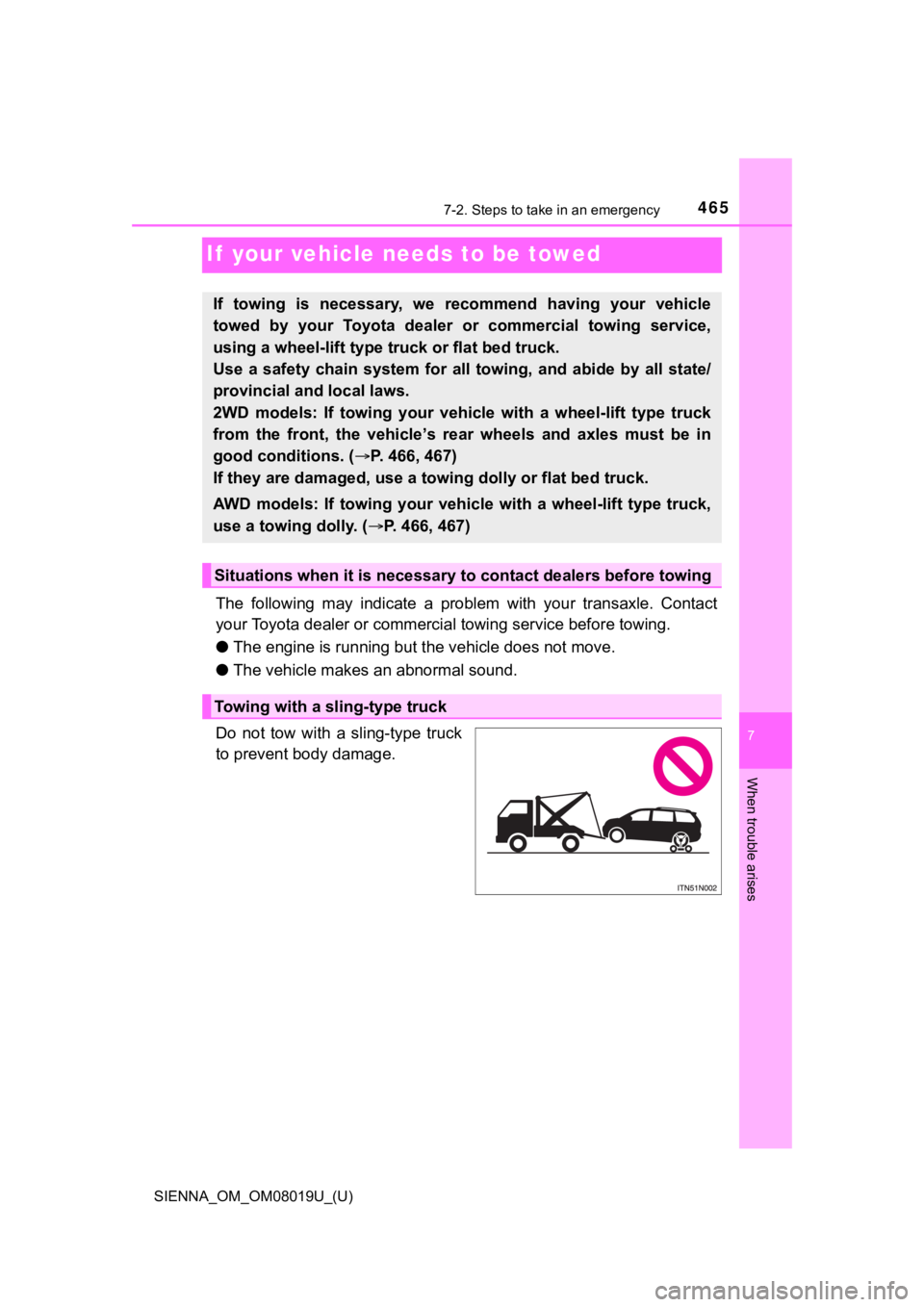
465
SIENNA_OM_OM08019U_(U)
7-2. Steps to take in an emergency
7
When trouble arises
If your vehicle needs to be towed
The following may indicate a problem with your transaxle. Contact
your Toyota dealer or commercial towing service before towing.
● The engine is running but t he vehicle does not move.
● The vehicle makes an abnormal sound.
Do not tow with a sling-type truck
to prevent body damage.
If towing is necessary, we recommend having your vehicle
towed by your Toyota dealer o r commercial towing service,
using a wheel-lift type t ruck or flat bed truck.
Use a safety chain system for all towing, and abide by all stat e/
provincial and local laws.
2WD models: If towing your vehic le with a wheel-lift type truck
from the front, the vehicle’s rear wheels and axles must be in
good conditions. ( P. 466, 467)
If they are damaged, use a to wing dolly or flat bed truck.
AWD models: If towing your vehicle with a wheel-lift type truck ,
use a towing dolly. ( P. 466, 467)
Situations when it is necessary to contact dealers before towing
Towing with a sling-type truck
Page 469 of 584
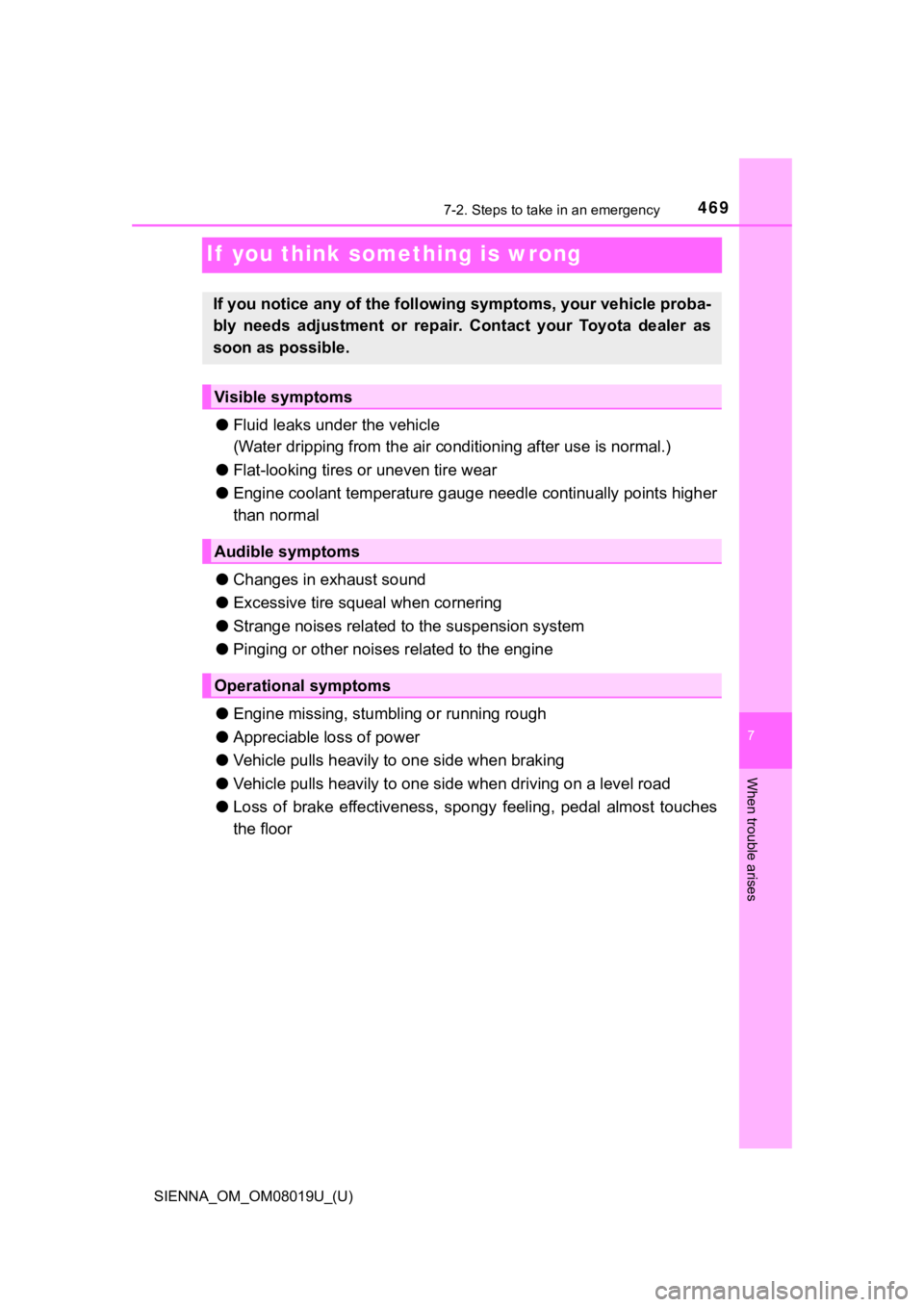
469
SIENNA_OM_OM08019U_(U)
7-2. Steps to take in an emergency
7
When trouble arises
If you think something is wrong
●Fluid leaks un der the vehicle
(Water dripping from the air conditioning a fter use is normal.)
● Flat-looking tires or uneven tire wear
● Engine coolant temperature gauge needle continually points high er
than normal
● Changes in exhaust sound
● Excessive tire squeal when cornering
● Strange noises related to the suspension system
● Pinging or other noises related to the engine
● Engine missing, stumbling or running rough
● Appreciable loss of power
● Vehicle pulls heavily to one side when braking
● Vehicle pulls heavily to one s ide when driving on a level road
● Loss of brake effectiveness, spongy feeling, pedal almost touch es
the floor
If you notice any of the followi ng symptoms, your vehicle proba -
bly needs adjustment or repair. Contact your Toyota dealer as
soon as possible.
Visible symptoms
Audible symptoms
Operational symptoms
Page 478 of 584

4787-2. Steps to take in an emergency
SIENNA_OM_OM08019U_(U)
WARNING
■If both the ABS and the brake s ystem warning lights remain on
Stop your vehicle in a safe place immediately and contact your To y o t a
dealer. The vehicle will become extremely unstable during braki ng, and the
ABS system may fail, which could cause an accident resulting in death or
serious injury.
■ When the electric power steering system warning light comes on
The steering wheel may become extremely heavy.
When steering wheel operations are heavier than usual, grip the steering
wheel firmly and operate it using more force than usual.
■
If the tire pressure warning light comes on
Be sure to observe the following precautions. Failure to do so could
cause a loss of vehicle control and result in death or serious injury.
Vehicles with standard tires:
●Stop your vehicle in a safe place as soon as possible. Adjust t he tire
inflation pressure immediately.
●If the tire pressure warning light comes on even after tire inf lation pres-
sure adjustment, it is probable that you have a flat tire. Chec k the tires.
If a tire is flat, change it with the spare tire and have the f lat tire
repaired by the nearest Toyota dealer.
●Avoid abrupt maneuvering and braking. If the vehicle tires dete riorate,
you could lose control of the steering wheel or the brakes.
Vehicles with run-flat tires:
●Decelerate to the lowest appropriate speed as soon as possible. Do
not drive over 50 mph (80 km/h).
●Check and adjust the tire infl ation pressure immediately.
●If the tire pressure warning light comes on even after tire inf lation pres-
sure adjustment, it is probable that you have a flat tire. Have the tire
replaced by the nearest Toyota dealer.
●Avoid abrupt maneuvering and braking. If the vehicle tires dete riorate,
you could lose control of the steering wheel or the brakes.
■If a blowout or sudden air leakage should occur
The tire pressure warning system may not activate immediately.
Page 487 of 584

4877-2. Steps to take in an emergency
SIENNA_OM_OM08019U_(U)
7
When trouble arises
WARNING
■Using the tire jack
Observe the following precautions.
Improper use of the tire jack may cause the vehicle to suddenly fall off
the jack, leading to death or serious injury.
●Do not use the tire jack for any purpose other than replacing t ires or
installing and removing tire chains.
●Only use the tire jack that comes with this vehicle for replacing a flat
tire. Do not use it on other vehicles, and do not use other tir e jacks for
replacing tires on this vehicle.
●Put the jack properl y in its jack point.
●Do not put any part of your body under the vehicle while it is supported
by the jack.
●Do not start or run the engine while your vehicle is supported by the
jack.
●Do not raise the vehicle w hile someone is inside.
●When raising the vehicle, do not put an object on or under the jack.
●Do not raise the vehicle to a height greater than that required to
replace the tire.
●Use a jack stand if it is nece ssary to get under the vehicle.
●When lowering the vehicle, make sure that there is no-one near the
vehicle. If there are people nearb y, warn them vocally before lowering.
Page 499 of 584
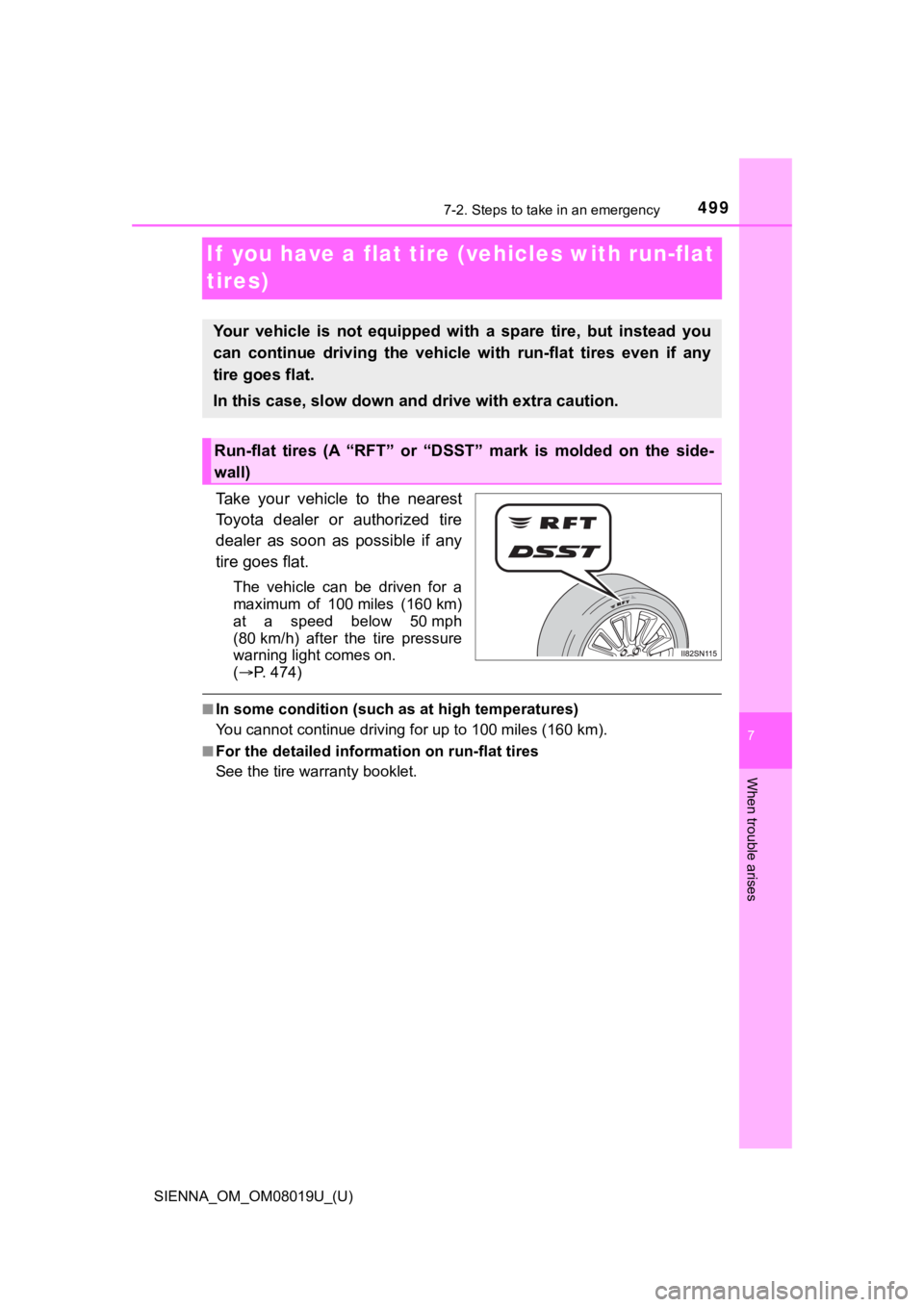
499
SIENNA_OM_OM08019U_(U)
7-2. Steps to take in an emergency
7
When trouble arises
If you have a flat tire (vehicles with run-flat
tires)
Take your vehicle to the nearest
Toyota dealer or authorized tire
dealer as soon as possible if any
tire goes flat.
The vehicle can be driven for a
maximum of 100 miles (160 km)
at a speed below 50 mph
(80 km/h) after the tire pressure
warning light comes on.
( P. 474)
■In some condition (such as at high temperatures)
You cannot continue driving for up to 100 miles (160 km).
■For the detailed informa tion on run-flat tires
See the tire warranty booklet.
Your vehicle is not equipped with a spare tire, but instead you
can continue driving the vehicle with run-flat tires even if any
tire goes flat.
In this case, slow down and drive with extra caution.
Run-flat tires (A “RFT” or “DSST” mark is molded on the side-
wall)